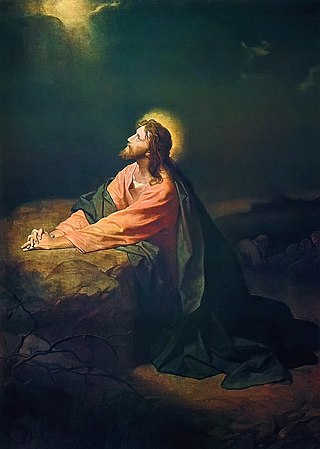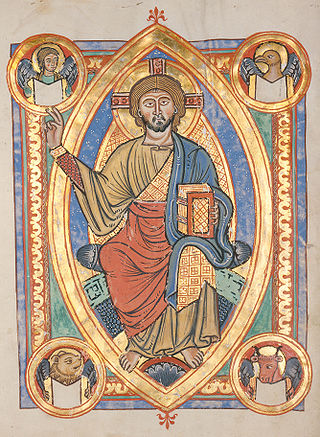| |
| Part of a series on |
| Acts of reparation of the Catholic Church |
|---|
 |
| Acts |
| |
The First Thursdays Devotion, also called the Act of Reparation to the Wounds of Jesus and to the Holy Eucharist, is a Catholic devotion to offer acts of reparation.
| |
| Part of a series on |
| Acts of reparation of the Catholic Church |
|---|
 |
| Acts |
| |
The First Thursdays Devotion, also called the Act of Reparation to the Wounds of Jesus and to the Holy Eucharist, is a Catholic devotion to offer acts of reparation.
There was already at this time a long-standing first Thursdays devotion that involved praying the Respice, Domine ("Look down, O Lord"), a prayer attributed to Saint Cajetan. [note 1] The prayer was to be said while kneeling before the Blessed Sacrament. A plenary indulgence was granted for the first Thursday in each month to all who would say it after confession and communion and pray for the needs of the Church. Partial indulgences were granted for saying the prayer at other times. [1] Cajetan's prayer echoes Psalm 120, and was popular as a plea for help and protection in times of trouble.
Eucharistic adoration during a "Holy hour" on Thursdays was part of the revelations reported by Margaret Mary Alacoque. [2] Pope Pius VI granted a plenary indulgence for those who would visit the Blessed Sacrament on the first Thursday of the month. [3] Picpus Father Mateo Crawley-Boevey (1875-1960) promoted an at-home Holy Hour for those who couldn't make it to an oratory or chapel.
According to Alexandrina Maria da Costa, popularly known as Alexandrina of Balazar, she experienced an apparition of Jesus on 25 February 1949, during which he requested a new devotion in reparation for his Holy Wounds, to be practiced on the first Thursday of six consecutive months.The number six represents Jesus' five wounds of the Crucifixion (hands, feet, and side) plus his shoulder wound from carrying the cross. On these days, a person is to attend the Mass and receive the Eucharist in a state of grace "with sincere humility, fervor and love" and spend one hour before a church tabernacle containing the Eucharist, meditating on the wounds of Jesus (particularly his shoulder wound) and the sorrows of Mary. This devotion to the Holy Wounds through Eucharistic adoration was approved by the Roman Catholic Church. [4] [5]
The Salvatorians initiated a First Thursday devotion for sanctification of the priesthood. [6]

The Most Sacred Heart of Jesus is one of the most widely practised and well-known Catholic devotions, wherein the heart of Jesus Christ is viewed as a symbol of "God's boundless and passionate love for mankind". This devotion to Christ is predominantly used in the Catholic Church, followed by high-church Anglicans, and some Western Rite Orthodox. In the Latin Church, the liturgical Solemnity of the Most Sacred Heart of Jesus is celebrated the third Friday after Pentecost. The 12 promises of the Most Sacred Heart of Jesus are also extremely popular.
In Catholic tradition, the Five Holy Wounds, also known as the Five Sacred Wounds or the Five Precious Wounds, are the five piercing wounds that Jesus Christ suffered during his crucifixion. The wounds have been the focus of particular devotions, especially in the late Middle Ages, and have often been reflected in church music and art.

Margaret Mary Alacoque, VHM, was a French Catholic Visitation nun and mystic who promoted devotion to the Sacred Heart of Jesus in its modern form.

The Fátima prayers are a collection of seven Catholic prayers associated with the 1917 Marian apparitions at Fátima, Portugal. Of the seven prayers, reportedly, the first two were taught to the three child visionaries by the Angel of Peace, the next three were taught to the children by Our Lady of Fátima herself during the course of the apparitions, and the final two were taught to Lúcia dos Santos, the eldest and last survivor of the three, in 1931 by Jesus when she was already a nun. Of the seven prayers, the Rosary Decade Prayer is the best-known and the most widely recited. For each prayer below, an English translation is given alongside the Portuguese original.

The Pontevedra apparitions are the Marian apparition of Mary, mother of Jesus and her child, Jesus, that Sister Lúcia, the Portuguese seer of Our Lady of Fátima, reported receiving in December 1925, while living in a Dorothean convent in Pontevedra, Spain, and a visitation of the child Jesus by himself in February 1926, near the convent's garden.

The agony in the Garden of Gethsemane is an episode in the life of Jesus, which occurred after the Last Supper and before his betrayal and arrest, all part of the Passion of Jesus leading to his crucifixion and death. This episode is described in the three Synoptic Gospels in the New Testament. According to these accounts, Jesus, accompanied by Peter, John and James, enters the garden of Gethsemane on the Mount of Olives where he experiences great anguish and prays to be delivered from his impending suffering, while also accepting God's will.

Alexandrina Maria da Costa, best known as Blessed Alexandrina of Balazar, was a Portuguese mystic and victim soul, member of the Association of Salesian Cooperators, who was born and died in Balazar. On 25 April 2004, she was declared blessed by Pope John Paul II who stated that "her secret to holiness was love for Christ".

Eucharist is the name that Catholics give to the sacrament by which, according to their belief, the body and blood of Christ are present in the bread and wine that are consecrated during the Catholic eucharistic liturgy, generally known as the Mass. The definition of the Eucharist in the 1983 Code of Canon Law as the sacrament where Christ himself "is contained, offered, and received" points to the three aspects of the Eucharist according to Catholic theology: the real presence of Christ in the Eucharist, Holy Communion, and the holy sacrifice of the Mass.

Catholic devotions are particular customs, rituals, and practices of worship of God or honour of the saints which are in addition to the liturgy of the Catholic Church. The United States Conference of Catholic Bishops describes devotions as "expressions of love and fidelity that arise from the intersection of one's own faith, culture and the Gospel of Jesus Christ". Devotions are not considered part of liturgical worship, even if they are performed in a church or led by a priest, but rather they are paraliturgical. The Congregation for Divine Worship at the Vatican publishes a Directory on Popular Piety and the Liturgy.

Holy Hour is the Roman Catholic devotional tradition of spending an hour in Eucharistic adoration in the presence of the Blessed Sacrament. A plenary indulgence is granted for this practice. The practice is also observed in some Lutheran churches and some Anglican churches.

The Holy Face of Jesus is a title for specific images which some Catholics believe to be miraculously formed representations of the face of Jesus Christ. The image obtained from the Shroud of Turin is associated with a specific medal worn by some Roman Catholics and is also one of the Catholic devotions to Christ.

Thanksgiving after Communion is a spiritual practice among Christians who believe in the Real Presence of Jesus Christ in the Communion bread, maintaining themselves in prayer for some time to thank God and especially listening in their hearts for guidance from their Divine guest. This practice was and is highly recommended by saints, theologians, and Doctors of the Church.

Three Hail Marys are a traditional Roman Catholic devotional practice of reciting Hail Marys as a petition for purity and other virtues. Believers recommend that it be prayed after waking in the morning, and before going to bed. This devotion has been recommended by SS. Anthony of Padua, Alphonsus Liguori, John Bosco and Leonard of Port Maurice. Two saints, Mechtilde and Gertrude the Great, are said to have received revelations from the Blessed Virgin Mary regarding this practice.

The traditional prayer in honor of the shoulder wound of Jesus calls to mind the wound that Jesus is said to have received carrying the cross on which he was crucified. It is variously attributed to Saint Bernard of Clairvaux or to Saint Gertrude or Saint Mechtilde.

Reparation is a Christian theological concept closely connected with those of atonement and satisfaction. In ascetical theology, reparation is the making of amends for insults given to God through sin, either one's own or another's. The response of man is to be reparation through adoration, prayer, and sacrifice. In Roman Catholic tradition, an act of reparation is a prayer or devotion with the intent to expiate the "sins of others", e.g. for the repair of the sin of blasphemy, the sufferings of Jesus Christ or as Acts of Reparation to the Virgin Mary.

Catholic tradition and Mariology include specific prayers and devotions as acts of reparation for perceived insults and blasphemies against Mary, mother of Jesus, often known as the Blessed Virgin Mary to Catholics. Similar prayers as Acts of Reparation to Jesus Christ and Acts of Reparation to The Holy Trinity also exist.

The Roman Catholic tradition includes a number of devotions to Jesus Christ. Like all Catholic devotions, these prayer forms are not part of the official public liturgy of the Church but are based on the popular spiritual practices of Roman Catholics. Many are officially approved by the Holy See as suitable for spiritual growth but not necessary for salvation.

A number of prayers to Jesus Christ exist within the Roman Catholic tradition. These prayers have diverse origins and forms. Some were attributed to visions of saints, others were handed down by tradition.

The "Alliance of the Hearts of Jesus and Mary" is a phrase coined by Pope John Paul II during his Angelus Address of September 15, 1985 when he mentioned that devotion to the Sacred Heart of Jesus and to the Immaculate Heart of Mary, "...though distinct, they are interrelated by reason of the enduring relation of love that exists between the Son and his Mother." Subsequently, several symposia were held to examine its roots and implications. Since there had been much research in Devotion to the Sacred Heart, the conferences tended to focus on the devotion to the Immaculate Heart of Mary in the perspective of Sacred Scripture and Tradition.

Spiritual communion is a Christian practice of desiring union with Jesus Christ in the Eucharist. It is used as a preparation for Mass and by individuals who cannot receive holy communion.